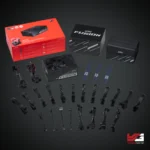
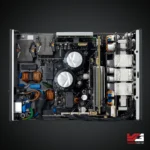
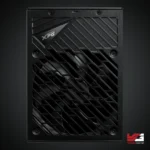
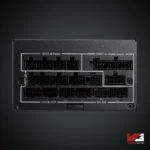
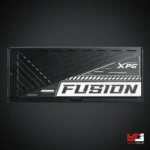
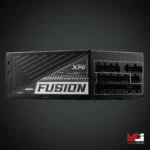
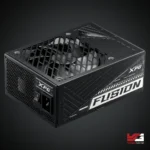
₨ 165,000
- Fully modular 1600 W ATX 3.1 / PCIe 5.0 compliant PSU
- Dual 12VHPWR connectors + multi-rail GPU support
- Multi-MCU digital control via XPG Prime software
- Patented planar transformer and GaN FET design
- Built-in fault protections (OCP, OVP, SCP, OTP, etc.)
- 2-year warranty and real-time monitoring capabilities
In stock
RELATED PRODUCTS
THERMALRIGHT TB-650 80 PLUS BRONZE CERTIFIED POWER SUPPLY
-
650W Continuous Output – Provides stable power for gaming PCs and workstations.
-
80 PLUS Bronze Certified – Ensures energy efficiency and reduced power consumption.
-
Full-Modular Design – Allows for customizable cable management and improved airflow.
-
Comprehensive Protection Features – Includes OPP, OVP, OTP, OCP, SCP, and UVP for system safety.
-
5-Year Warranty – Offers long-term reliability and peace of mind
In Stock
ASUS ROG THOR 1000W PLATINUM II GAMING POWER SUPPLY
- 80 PLUS Platinum Certification: Ensures high energy efficiency and reduced power consumption.
- ROG Heatsinks and Axial-tech Fan: Provide superior cooling performance and extended component lifespan.
- Lambda A++ Certification: Confirms ultra-quiet operation, making it the quietest PSU in its class.
- Aura Sync RGB Lighting: Offers customizable lighting effects to match your system's aesthetics.
- Fully Modular Design: Allows for clean and organized cable management.
Cooler Master 1600 V-Platinum V2 FM PSU Power Supply
- 1600W Power Output: Delivers stable and efficient power for high-end gaming PCs and workstations
- 80 PLUS Platinum Efficiency: Up to 92% energy efficiency, reducing power consumption and heat output
- Fully Modular Design: Allows for customized cable management, improving airflow and aesthetics
- Premium Cooling: Features a 135mm FDB fan for quiet operation and optimal heat dissipation
- High-Quality Components: Built with Japanese capacitors and premium materials for long-term reliability
- 10-Year Warranty: Ensures durability and reliability for extended use
In stock
THUNDER TGS-750W POWER SUPPLY
- 750W 80+ Gold Certified Efficiency – Reduces power consumption and heat generation while ensuring stable performance.
- Full Modular Cable Design – Allows better cable management, improved airflow, and a cleaner PC build.
- Japanese Capacitors for Durability – Ensures stable voltage regulation and long-lasting reliability for high-performance systems.
- Intelligent Cooling Fan – Operates quietly while dynamically adjusting speeds to maintain optimal system temperature.
- Comprehensive Safety Protections – Includes over-voltage, over-current, short-circuit, and overload protection for secure operation.
In Stock
XPG 750W GOLD COREREACTOR II Gaming Power Supply MODULAR
- ATX 3.0 & 3.1 Compliance – Fully compatible with next-gen components, including 12VHPWR GPUs
- 80 PLUS GOLD Certified – Achieves up to 91.40% efficiency, reducing power waste and heat output
- Intelligent Fan-Curve Design – Optimized cooling system ensures low noise levels and extended fan life
- Premium Japanese Capacitors – 105°C capacitors provide superior stability and long-lasting performance
- Eight Industrial-Grade Protections – Includes over-voltage, short-circuit, and power surge protection
- Fully Modular Cable Design – Reduces clutter, improves airflow, and enhances overall system aesthetics
XPG 1600T FUSION TITANIUM Gaming Power Supply MODULAR Price In Pakistan :
Comprehensive Review & Buying Guide

XPG 1600T FUSION TITANIUM Gaming Power Supply MODULAR Price In Pakistan
XPG Fusion: Elevating the PC Components Ecosystem
In an age where performance, efficiency, and modularity are no longer optional but essential, the XPG Fusion series stands as a flagship ecosystem uniting power supplies, software control, and smart hardware integration. We present a comprehensive, in-depth overview of the XPG Fusion platform: its architecture, advantages, deployment use-cases, future readiness, and comparison with alternatives.
1. Understanding XPG Fusion: Vision & Architecture
At its core, XPG Fusion is more than a standalone power supply—it’s an integrated architecture designed to unify power, modular control, and system intelligence under one cohesive platform. Each Fusion power unit links to the software layer, enabling dynamic control, diagnostics, and synergy with ancillary hardware.
- Unified Ecosystem Model
XPG sees future PC builds not as discrete components, but as interoperable modules. Fusion is the backbone: the PSU not only supplies power, but also communicates with fans, thermal sensors, RGB controllers, and system software in real time. - Scalable & Modular Topology
Fusion devices support daisy-chaining, modular cabling, and expansion through OC Link (a proprietary interconnect bus). You can scale a system while preserving control and monitoring consistency. - Standards Compliance & Readiness
The architecture is built around ATX 3.1 / ATX 3.0 compliance and PCIe 5.0 / 12VHPWR support. This ensures that end users adopting Fusion are ready for next-gen GPUs, CPUs, and power draw behaviors. - Redundancy & Failover Logic
Through multi-MCU configurations, Fusion isn’t a single point failure. In advanced implementations, parallel Fusion units can operate in synchronization, handing off load in case one unit fails or is taken offline.
2. Power Supply Engineering: Core Features & Design
The engineering advances underlying the Fusion line are what distinguish it from conventional PSUs. Let’s explore the key pillars of its design.
2.1 Patented Planar Transformer + GaN FET topology
One of the most notable innovations in Fusion is the planar transformer design, co-developed with Delta Electronics. Compared to conventional toroidal or EI transformers, planar types offer:
- High power density in thinner form factors
- Lower electromagnetic interference (EMI) footprint
- Better thermal coupling and heat dissipation
Coupled with Gallium Nitride (GaN) FETs, the unit achieves switching efficiency at higher frequencies with lower switching losses, enabling compactness without compromising power throughput.
2.2 100% Japanese capacitors rated at 105 °C
All capacitors in Fusion’s power topology are premium Japanese-made units capable of continuous operation at 105 °C. This offers:
- Stable voltage under high thermal load
- Longer lifespan and reliability
- Lower ESR and ripple behavior
2.3 Digital Multi-MCU Control & Monitoring
Instead of a single microcontroller, Fusion uses a multi-MCU architecture to distribute responsibilities:
- One MCU handles LLC resonant switching control
- Another MCU manages monitoring (voltage, current, temperature)
- A further MCU handles software interface, alerts, and protections
This separation of concerns ensures no module is overloaded, and fault isolation is more robust.
2.4 Full Modular Connectivity & Connector Design
Fusion supports a broad array of connectors:
- 24-pin ATX (fully modular)
- Dual EPS / CPU rails
- Native 12VHPWR / dual-12V (2 × 6-pin) GPU connectors
- Multiple PCIe 6+2 pin, SATA, Molex, and floppy
All cable runs use thick gauge wiring and consistent length standards to preserve signal integrity and limit voltage drop.
2.5 Protection Suite & Reliability
Fusion includes extensive protections:
- Over Current (OCP)
- Over Voltage (OVP)
- Under Voltage (UVP)
- Short Circuit (SCP)
- Over Power (OPP)
- Over Temperature (OTP)
- No Load Operation (NLO)
- Surge & Inrush Protection (SIP)
Accompanied by a 2-year warranty, these protections underscore the engineering confidence in longevity.
3. Software Integration: XPG Prime, Monitoring & Control
A vital component of Fusion’s value is its intelligent software integration. The XPG Prime ecosystem orchestrates real-time control, diagnostics, and cross-device communication.
3.1 Real-Time Monitoring Dashboard
Within XPG Prime, users see:
- Input / output voltages
- Power usage (Wattage)
- Efficiency percentages
- Temperature and fan RPM
- Historical logs and trend graphs
This data helps in diagnostics, tuning, and preventative maintenance.
3.2 Thermal / Fan Curve Customization
Users can choose from pre-set cooling profiles (e.g., Silent, Balanced, Performance), or design custom curves mapping load vs. fan RPM. In many cases, the fan remains off (hybrid mode) until loads exceed a threshold (e.g. 600 W).
3.3 Voltage & OCP Fine-Tuning
While voltage adjustments are limited (to preserve safety margins), users can:
- Slightly offset rail voltages
- Adjust OCP thresholds (lower them, not exceed spec)
- Choose single-rail or multi-rail behavior on 12V rail segments
These adjustments offer expert users fine control over power delivery behavior.
3.4 Alerts, Logging & Event Notifications
Prime can send alerts when:
- Thermal threshold exceeded
- Voltage out-of-range
- OCP events triggered
- Component logs show anomalous behavior
Logs are storable over minutes, hours, or days—ideal for long-term system monitoring.
3.5 Cross-Device & Ecosystem Sync
XPG Prime is more than PSU control; it communicates with other XPG hardware (e.g. RGB controllers, fans, cooling units) enabling:
- Coordinated thermal responses
- Synchronized profile adjustments
- Unified firmware updates
This synergy is central to the Fusion vision.
4. Thermal & Cooling Synergy in the Fusion Ecosystem
Power and thermal systems must co-operate seamlessly. Fusion’s architecture ensures that cooling is not an afterthought but an integrated pillar.
4.1 Fan & Thermal Sensor Placement
By integrating precise sensors in PSU compartments and connecting via the OC Link bus to chassis fans and water-cooling controllers, Fusion ensures thermal awareness extends beyond the PSU to the entire thermal zone—CPU, GPU, VRMs.
4.2 Cooling Profiles in Context
Depending on system load and temperature data, Fusion enables dynamic cooling decisions:
- Lower fan speeds when ambient is cool
- Coordinated boosts when both GPU and PSU heat rise
- Predictive ramp-up when peak loads are anticipated (e.g. heavy rendering)
4.3 Acoustic Optimization
At moderate loads (< 50 %), Fusion maintains very low noise output, often silent, enabling quiet desktop use. At extreme power draws, the system transitions smoothly to higher RPM curves—maintaining system safety over silence.
4.4 Thermal Scalability in Multi-Unit Deployments
In multi-Fusion architectures, thermal loads are distributed. If one unit gets hot, load balancing can shift draw across units while coordinated fan curves maintain overall acoustics.
5. Real-World Use Cases & Deployment Scenarios
Understanding how Fusion shines in practice helps showcase its advantages. Here we explore deployment scenarios:
5.1 High-End Gaming / Workstation Builds
Modern GPUs (e.g. next-gen 40/50 series) may draw 500–600 W each via 12VHPWR. Fusion’s native support means direct power delivery, no adapters, and stable voltage even under excursion demands.
5.2 Multi-GPU & Compute Rigs
For rendering, AI, mining, or compute farms, Fusion supports multi-unit configurations (via OC Link), enabling load sharing, redundancy, and synchronized monitoring across each node.
5.3 Server & Workstation Redundancy
In mission-critical deployments, dual or parallel Fusion units can operate in redundant mode. Should one crash, the other instantly takes over—minimizing downtime.
5.4 Long-Life, Long-Term Builds
With its 2-year warranty, premium components, and real-time monitoring, Fusion is ideal for systems expected to last a decade: the PSU becomes a long-term investment, not a consumable.
5.5 Overclocking & Enthusiast Systems
Users pushing extreme overclocks can use Prime’s controls to fine-tune OCP thresholds, thermal fan curves, and voltage offsets—extracting every ounce of stability under high stress.
6. Comparative Landscape & Future Outlook
For Fusion to outrank, we must situate it in the broader PSU and ecosystem market and see where it goes next.
6.1 Competitors & Alternatives
- Corsair AX / HX / RM Series: Strong legacy in reliability, analog control, and low noise—but limited in native 12VHPWR support and digital integration.
- Seasonic PRIME Series: Known for electrical purity and silence but less integrated intelligence and ecosystem control.
- ASUS / ROG / Cooler Master offerings: Strong in motherboard synergy, but often lack the depth of power-centric architectures Fusion provides.
6.2 Fusion’s Differentiators
- Native ecosystem control (not bolt-on)
- Advanced transformer + GaN topology
- Multi-MCU fault-resilience design
- High scalability via OC Link
- Future proof-ready for ATX 3.1 & PCIe 5.0
6.3 Challenges & Adoption Barriers
- Cost Premium: Fusion will command a high upfront price due to its engineering.
- Size & Case Compatibility: The longer chassis can conflict with compact case builds.
- User Learning Curve: Full control and tuning require understanding beyond plug-and-play.
- Ecosystem Dependence: Full benefit is unlocked only when other components (fans, RGB, sensors) integrate via XPG.
6.4 Roadmap & Evolution
- Lower-Wattage Fusion variants for mainstream consumers
- Fusion-enabled cooling / chassis modules that plug directly into OC Link
- Firmware upgrades enhancing monitoring, predictive analytics, and self-diagnostics
- Cloud sync & alerting so users get mobile alerts from their desktop system
In sum, Fusion is not a one-product launch—it’s the beginning of a holistic, intelligent PC component ecosystem.
Wrapping Up:
XPG 1600T FUSION TITANIUM Gaming Power Supply MODULAR Price In Pakistan: The XPG Fusion architecture is not merely a next-generation PSU, but the central pillar of a modular, intelligent, and future-proof PC ecosystem. Through its patented engineering, deep software integration, and thermal synergy, Fusion offers unparalleled control, reliability, and scalability. For users building systems intended to last years, handle extreme workloads, or integrate multiple units, Fusion presents a compelling proposition.
We urge forward-thinking builders to adopt Fusion not as an upgrade, but as a foundation upon which future PC systems will be constructed.
FAQs
Q1: What makes XPG Fusion different from regular power supplies?
The Fusion series integrates modular hardware with intelligent software, uses patented planar transformer and GaN FET topology, and supports native 12VHPWR and ATX 3.1 compliance—making it far more advanced than conventional PSUs.
Q2: Is Fusion overkill for regular gaming PCs?
While many gaming setups do not currently draw 1600 W, Fusion invests in future readiness, thermal margins, and fine-grained control. Its silence and efficiency also benefit everyday builds—not just extreme rigs.
Q3: Can I use two or more Fusion units together?
Yes. Through the OC Link interface, multiple Fusion units can be daisy-chained to share load and operate in redundancy, offering both scalability and fault tolerance.
Q4: Will Fusion work with my existing motherboard and case?
Yes—so long as your case accommodates the PSU’s physical dimensions. Fusion’s cables and connectors follow standard ATX layouts. However, shorter, compact mini-ITX cases may require careful clearance planning.
Q5: Does the software control void warranty or stability?
No. The XPG Prime software is part of the designed architecture. Adjustments are limited to safe ranges (you can’t exceed manufacturer margins). All hardware protections remain fully enforced, and the 2-year warranty is maintained when used properly.
Product Specifications
| Dimensions (L × W × H) | 210 × 150 × 86 mm |
|---|---|
| 80 Plus Rating | TITANIUM |
| Cybenetics Rating | TITANIUM |
| ATX Version | ATX 3.1 |
| Protections | OCP, OVP, OPP, OTP, UVP, SCP, NLO, SIP |
| Certifications | CE, CB, FCC(IC), TUV, cTUVus, TUV S-Mark, NOM, BSMI, UKCA, CQC, EAC |
| PFC | > 0.99 |
| Input Voltage | 100–240V / 115–240V |
| Input Current | 15A | 8A |
| Input Frequency | 47–63 Hz |
| DC Output Voltage | +5V, +3.3V, +12V, -12V, +5Vsb |
| Total Output | 1300W / 1600W |
| Power Excursion | Up to 3760W (235% of rated power for 100μs) |
| Operating Temperature | Up to 50°C |
| Fan | 135 × 135 × 25 mm • Double Ball Bearing • 2700 ±10% RPM |
| MTBF | 125,000 hours @ 25°C |
| Connectors | ATX 24-pin: 1 EPS 8-pin: 2 PCI-E 6+2-pin: 10 12V-2×6 / 12VHPWR (12+4): 2 (600W) SATA: 12 Molex 4-pin: 4 Floppy 4-pin: 1 |
| Weight | Product: 2.5 kg • Cables: 1.84 kg (±5%) |
| Warranty | 2 Years |
| Brand |
XPG |
|---|---|
| Color |
Black |

Please allow a minimum of 1 working days for the processing of the order
Delivery times vary based on location:
- Lahore orders: 1-2 business days
- Out-off City orders: 2-4 business days





















Reviews
There are no reviews yet.